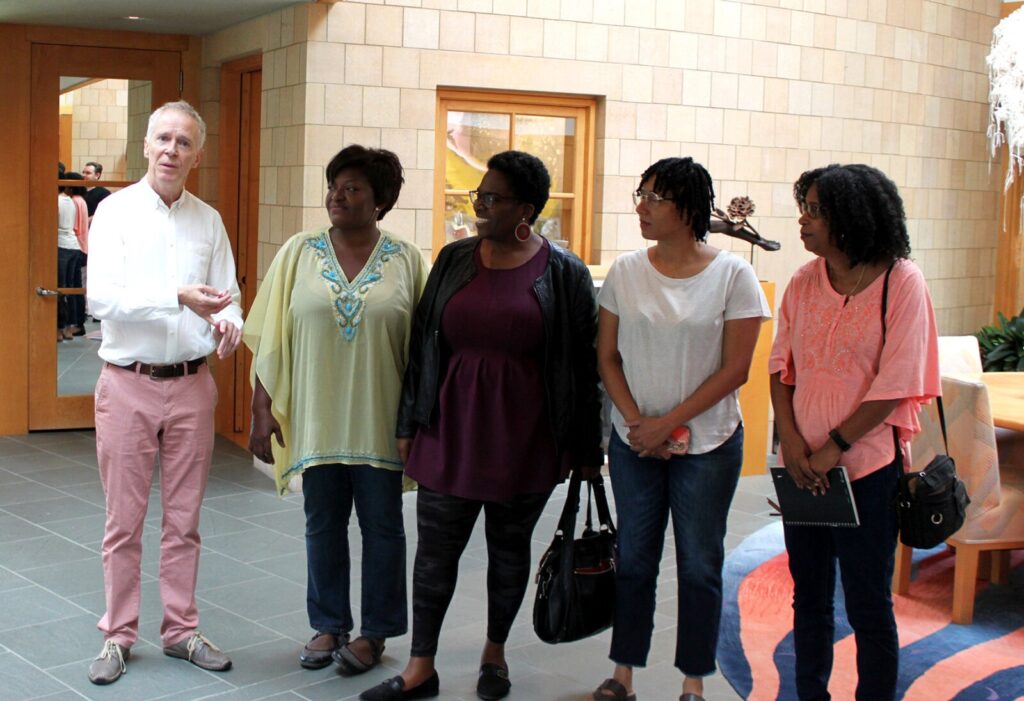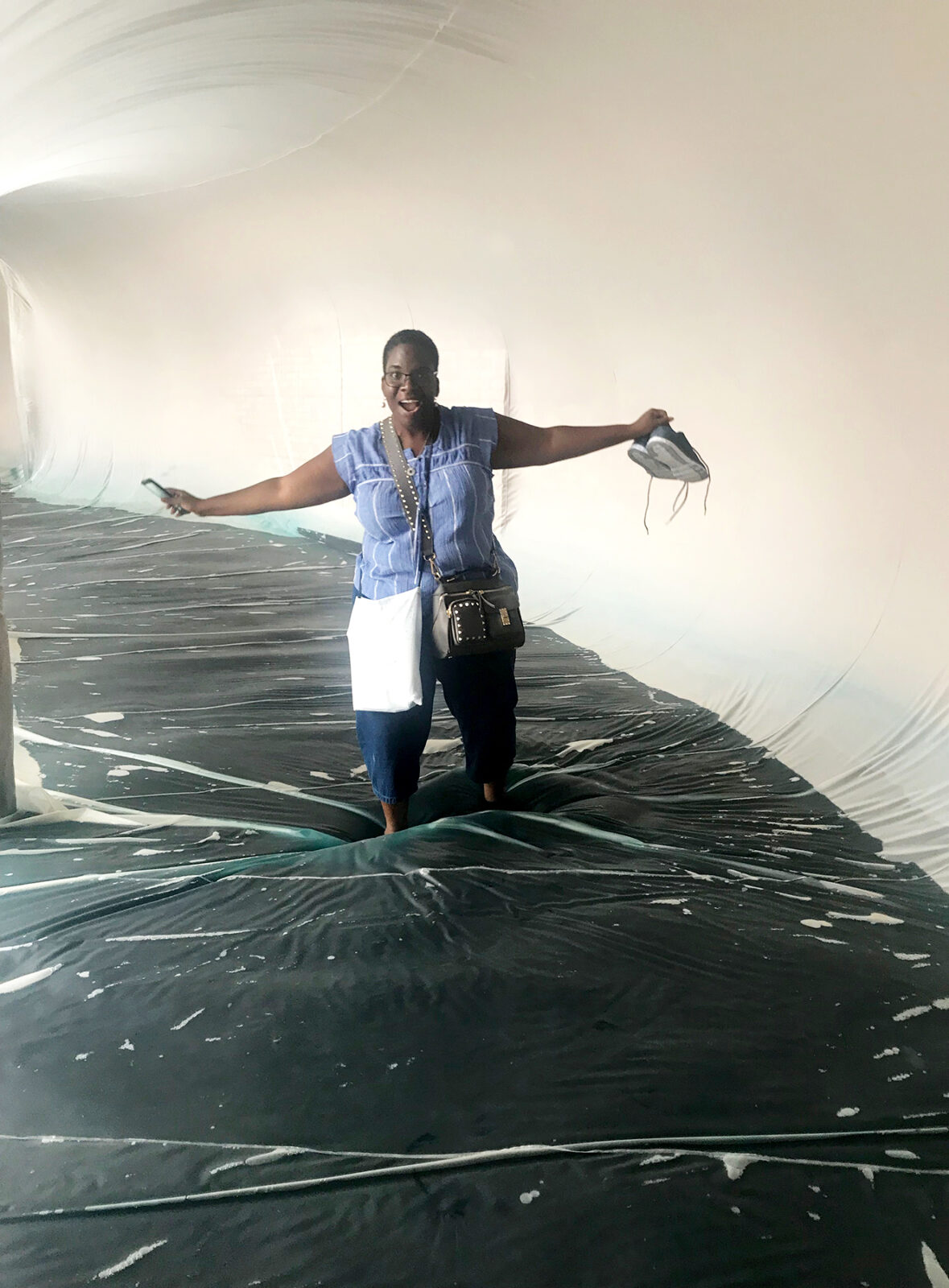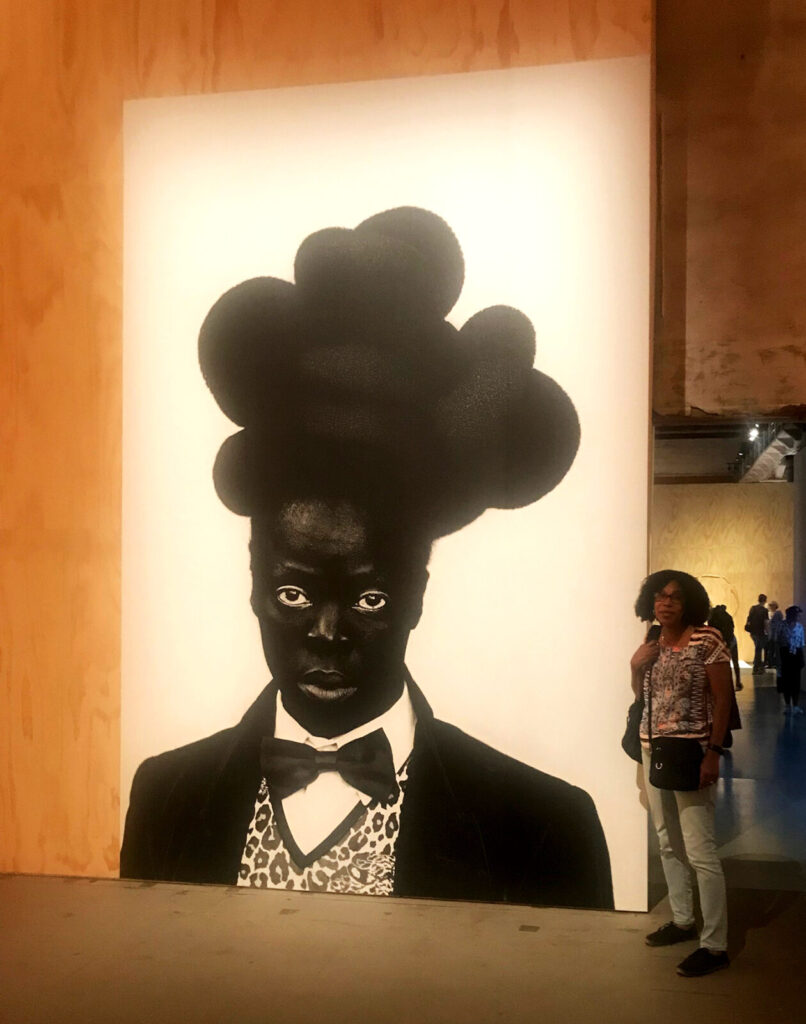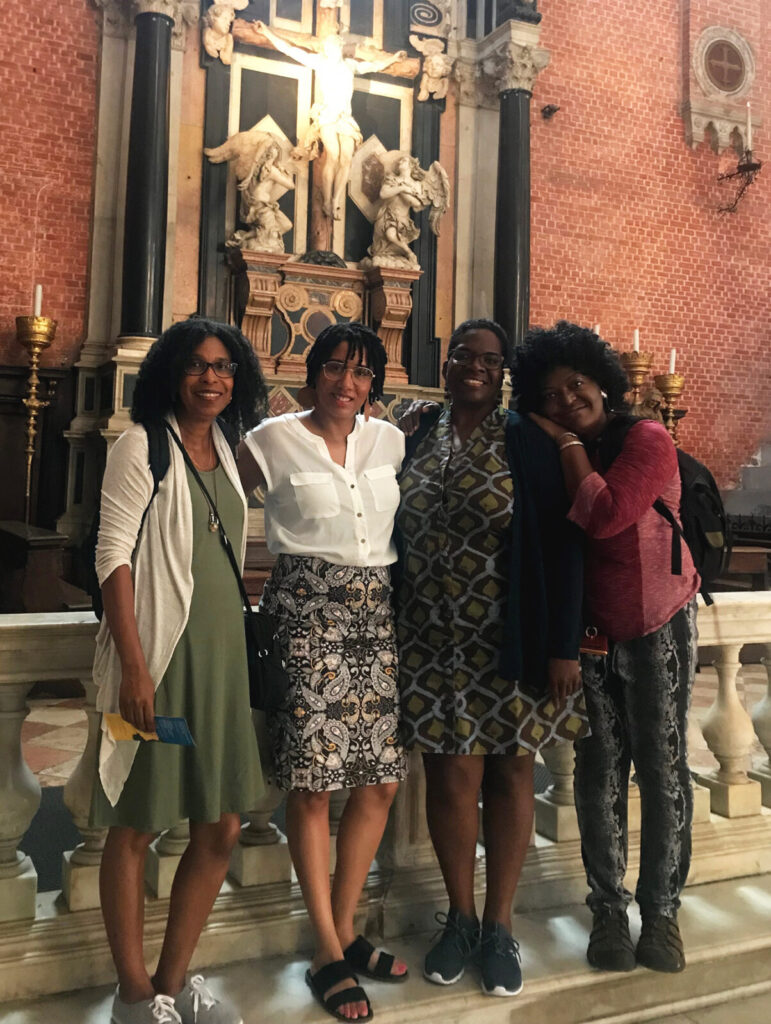Great Meadows Foundation, a grant-giving foundation launched in 2016 by contemporary art collector and philanthropist Al Shands, has steadily been upholding its commitments to contemporary art and artists in the state of Kentucky. The mission of the foundation is to “critically strengthen and support visual art in Kentucky by empowering our community’s artists and other visual arts professionals to research, connect, and participate more actively in the broader contemporary art world.”

In service of that mission, Great Meadows recently funded four artists to travel to Italy for the 58th Venice Biennale. Lucy Azubuike (Frankfort, KY), Sandra Charles, Ramona Dallum Lindsey, and Toya Northington (all Louisville, KY), traveled together to Venice on September 14, 2019, and spent six days visiting the Venice Biennale and satellite events and exhibitions. Great Meadows Foundation also provided a curatorial guide, Cecilia Holden, to help orient the artists in navigating the Biennale and its collateral events.
The trip was funded through a Great Meadows Foundation “bully” grant, an occasional, unsolicited grant awarded to artists who have not previously received support from the foundation. In the press release for the grant announcement, Julien Robson, Director of Great Meadows Foundation, described the “bully” grant, stating, “It allows the foundation to reach out to selected artists who have not yet received a grant and provide them with resources to visit significant exhibitions and events of the foundation’s choosing, where they can directly experience the works and ideas of important artists in the international contemporary art world.”
Upon their return from Venice, Azubuike, Charles, Lindsey, and Northington submitted reports to the foundation detailing their experiences and perspectives, portions of which are reproduced below. Supplemental questions were also provided to the artists by UnderMain in an effort to glean a holistic vision of how the trip has impacted their engagement with contemporary art in both the studio, and within the larger community. Their responses have been edited for brevity and clarity.
Lucy Azubuike:
This was a beautiful experience, even though in a city of water I could not find any water to dip my feet in, nor to swim! I tried but couldn’t, they were all blocked. Thank God for the Venice Pavilion and the Blurry Venice experience, even though I was only able to swim in barricaded water. Talk about having something you cannot reach. It was quite an experience.
I felt at home in Venice, considering that I am close to three artists that were showing at the Biennale; I have shown work with Zanele Muholi in the 2008 exhibit Like a Virgin, Njideka Crosby is literally my sister as we are both Igbos, while El Anatsui is my mentor.
What I saw was familiar to what I know about art: art is life, and the same artist can express art in different forms. The theme of the Biennale was “May You Live in Interesting Times.” This title in itself is an art. Ralph Rogoff, the 2019 Venice Biennale curator, opened our eyes to realize that every era is an interesting time from a different perspective.
Artists are able to ask open-ended questions, which force viewers to reexamine their views and positions about current issues. That was the strong aspect of this Biennale. They showcased what is happening in this era uniquely. For instance, this era’s interesting time is the Internet and globalization at its peak, so the question of boundaries toughens. What is a boundary? Is it virtual or real? Can a physical wall be real protection? Basically artists reveal the truth, which might not be pleasant, in unique ways.
This era has environmental dangers at its edge. The artists of the Lithuanian Pavilion highlighted that in their brilliant performance Sun & Sea (Marina). The French and Malaysian pavilions explored environmental degradation by man’s action and technology. I am a nature-art advocate, A.K.A. The Jungle Ambassador, representing the unrepresented. This trip availed me the opportunity to experience and document some tree-arts in Venice, especially in the Giardini. I am already writing a book exploring this regard of the trip.
The works at the Biennale are a testimony that art is more relevant in the world than ever and that people are beginning to appreciate and pay more attention to the prophesies of the artists. I am more energized to keep my art alive knowing that art is indispensable in our world.
Sandra Charles:
I am extremely grateful to Great Meadows Foundation for affording me the opportunity to visit the 2019 Venice Biennale and to have shared this experience with three exceptional African American female artists. This visit was enlightening and lifechanging to me both personally and professionally.
All the articles about the Biennale do not come close to the actual experience. My overall impression was amazement. I was overwhelmed by the enormity of the exhibit and the trip exceeded my expectations. The intensity, passion, and freedom that I found in each artwork was refreshing. I was impressed by the diversity of the cultures, mediums, and subjects. Each piece was unique and the artists’ responses to the theme “May You Live in Interesting Times” were just as unique and varied.
It was very meaningful for me to see an exhibit that included so many cultures. Even with the artwork I questioned, I was able to appreciate the passion behind the pieces. This to me was a challenge that I gratefully accepted. Art should make you think, should make you take another look at how you see the world and challenge your own point of view. Not only is the Biennale interesting, the city of Venice contains numerous exhibits and museums. You can view pieces from the Gothic and Renaissance periods at St. Marks, or Cubism and contemporary art at the Peggy Guggenheim Museum. The Biennale also had collateral exhibits. I was able to visit AFRICOBRA: Nation Time, an exhibit close to my heart. These were the artists that influenced my generation and helped shape the civil rights movement through their art.
Without a doubt the experience of visiting the Biennale and Venice had a profound impact on me as an artist. Even before the trip was over I found myself wanting to get back in my studio and push my art past the boundaries that I had set for myself. The art I viewed at the Biennale had a sense of freedom and confidence that I felt was lacking in my work. I was so impressed with the experience that I am rethinking my current series of paintings. This trip changed that perspective. If I had not agreed to attend the Biennale I would have missed my opportunity for inspiration. This was truly a life-changing trip. I am so grateful and so happy I chose to go outside my comfort zone. After visiting the Biennale I feel I am more aware of how art is approached internationally. The trip gave me a better understanding of how local art mirrors a larger art community. This visit made me more aware of the common thread that connects each artist, and that connection intensifies on a local basis. I am hoping that this opportunity will also be extended to other emerging African American artists. Such an experience is invaluable.

Ramona Dallum Lindsey:
My funding for the 2019 Venice Biennale experience did not come in the traditional way. It happened because a series of people stepped out of their comfort zone to try something different. Various paths lead to privilege. Wealth buys privilege. Race regulates privilege. Knowledge acquires privilege. Networks access privilege. Privilege brought me to my Biennale experience. It was the result of several people with privilege recognizing social, cultural, and economic inequity and consciously choosing to use their privilege to address it.
Cecilia Holden was one of the best additions to our experience. Our three-plus days with her allowed us to truly understand Italian culture. She introduced us to her friends and family and showed us what it was like to live in Venice. We learned the rationale behind a cash-only economy. She showed us the locals-only restaurant, accessible only by boat. And helped us understand why you don’t drink coffee in a to-go cup.
Vian Sora told me I would discover art as I wandered the streets of Venice. She told me not to be afraid to step inside open gallery doors and to anticipate art surprises around unsuspecting corners. I’m drawn to art that connects with my heart and mind. Art should make me feel something. There were several works at the Biennale that did nothing for me, but I saw my travel companions deeply engaged in discussion about the same works. They were drawn by technique, construction, or composition. Something in the work challenged their practice. Their example opened me up to looking at art and people from multiple perspectives and purposes.
In the Venice Pavilion lacemaking was immortalized in plaster and canvas. I was inspired to explore the endless possibilities of textiles and women’s work to stand on its own as contemporary art. Artists representing historically overlooked, misunderstood, or forgotten populations must boldly take every opportunity to transform majority controlled, privileged spaces into our spaces. Artists must be unflinching and daring to challenge the status quo. I traveled all the way to Venice to be reminded, “Say it loud! I’m Black and I’m Proud!” The AFRICOBRA: Nation Time exhibit brought me to tears. I traveled to Venice to reconnect with the power of the Black American experience. Gerald Williams’ Take It (1974), reminded me of my complexity, vibrancy, and textured reality. I am not African. I am not African American. I am a Black American.
Americans embrace a microwave mindset. We desire to obtain things quickly, succinctly, and easily. For Americans, obtaining knowledge and wisdom should be effortless. The ancient Venetian architecture, the melodic rhythm of the canals, and two-hour meals reminded me that history takes time. The Biennale art was abundant and complex. A cursory glance was insufficient for understanding. You had to linger with it, converse about it, and deeply reflect on it. This is a universal truth for understanding the complexities of this world.
Toya Northington:
I felt at home in Venice almost immediately. I never felt a sense of being othered or made to feel different. People were impressed to see African Americans there. The expectation was for Black tourists to be from Europe or another close country. Being from the United States was a sign of status. I also expected Venice to feel like an exotic, foreign place, but it looked a lot like home to me. I could see reminders of Old Louisville throughout the city with the cracked plastered walls, old fireplaces, decorative metalwork on the doors and windows, and stained glass. The more I explored the historic beauty of Venice, the more I appreciated my neighborhood at home.
Prior to the trip, I felt that I was on the side of the marginalized or less fortunate artist. In Atlanta I was an emerging artist, but in Louisville my work is mostly unknown. I questioned whether I was still a professional artist since I had not shown my work publicly in a few years. I was seeking validation and acceptance from the local art community.
All that changed once I arrived in Venice. Suddenly I was someone significant simply because I was African American and I was there. I walked a little taller and blended into the culture. Soon I realized some of the barriers that I had experienced were imagined or minute in comparison to my ability. Not only was I able to recognize my privilege, but I was also reminded of my responsibility to share my knowledge with other up-and-coming artists in my community.
This grant was a chance to see some of the most dynamic art being created today by African American artists and other people of color. I don’t see enough representation of this type of work being created and exhibited locally. Seeing the works in person fueled my confidence in my vision and ability as an artist. I came back to Louisville with a burning desire to create with an unrestricted freedom. All the questions that I had been asking about where to take my work were answered for me in Venice.
There is a formula for reaching your infinite potential as an artist that includes exposure to national and international art, resources, and time and space to create. Those luxuries are rare for African American women artists. If you aren’t connected to certain social circles you miss out on those opportunities. If you are invited to those spaces you must be prepared to be the only African American/Black person in the room. That means walking into a space where you are largely ignored or unseen. That’s why this grant and trip were so important. It was a movement or disruption of the status quo present in our art community. We are here to make space for other artists of color.
Additional information on the artists can be found on their websites:







